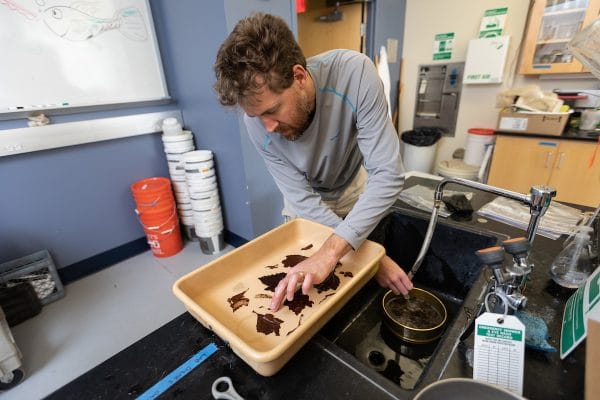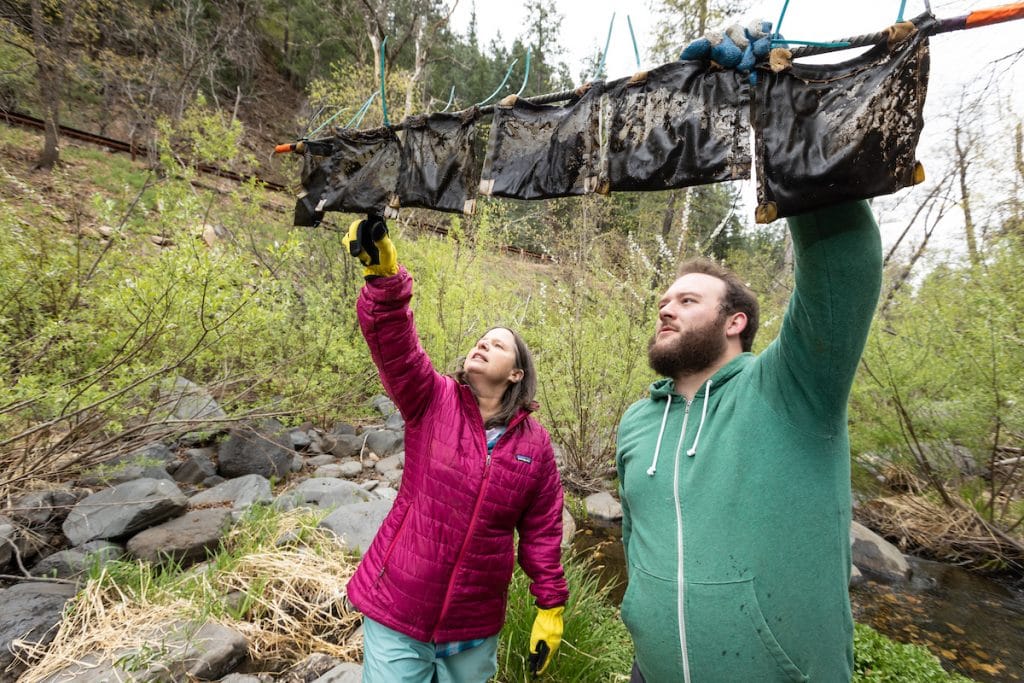Some experts estimate that a single mature oak tree produces between 200,000 and 1 million leaves each year—all of which fall from the tree in the autumn. Although “litter” from decaying leaves is sometimes viewed as a problem in urban and suburban settings, fallen leaves play a critical role in the natural world. Decomposing leaves replenish the soil by releasing carbon, nitrogen, phosphorus and other inorganic compounds into the food web, but scientists don’t yet have a complete understanding of this complex process or how it is being affected by climate change.
Stream ecologist Jane Marks, professor of biology and faculty of Northern Arizona University’s Center for Ecosystem Science and Society (Ecoss), studies the effects of leaf litter, chiefly within stream ecosystems.
Funded by a $942,000 grant from the National Science Foundation, Marks and her team are now starting the second year of a three-year project to investigate how traits of leaf litter—such as rate of decomposition, growth rates of microbes living there and water temperature—cascade to influence the amount and quality of nutrients released into food webs and ecosystems. Regents’ professor and Ecoss director Bruce Hungate, professor Egbert Schwartz and senior research associate Ben Koch also are on the team. The project, which NAU leads, has collaborators from Cornell University, University of New Hampshire and the University of Nebraska.
“Our research will transform the way scientists understand the link between terrestrial and aquatic environments by demonstrating differential pathways of energy and nutrient cycling of terrestrial derived litter through stream ecosystems,” Marks said. “It will provide new tools for scientists to predict how these pathways are likely to be affected by increasing temperatures and nitrogen deposition—two of the most prevalent disturbances resulting from climate change.”

Marks’ methods
For the first year of the project, Marks and her team, which includes many student scientists—undergraduates as well as graduate students—harvested samples from 12 different tree species grown in NAU’s greenhouse complex, including cottonwood, aspen, alder and oak. They placed the leaf litter in hand-crafted net bags that were hung from rebar and submerged in specific locations in Oak Creek near Sedona to decompose organically. The team carefully monitored their samples throughout the year so as to note seasonal changes in temperature and other phenological variations. Once the leaves had decayed, they were taken back to the Marks lab, where they were dried, labeled and examined.
The next steps in the project are for the researchers to use quantitative stable isotope probing, or qSIP, to measure microbial taxa growth rates on the decomposing leaves and in the digestive tracts of the insects living in the leaf litter, such as caddisflies. The technology, developed by NAU researchers in Ecoss, enables scientists to measure microbial growth by adding rare stable isotopes to the samples—tracers that contain heavy oxygen (18O)—and then sequencing DNA from the bacteria that incorporated that tracer.
“The use of qSIP to study complex microbial communities will revolutionize scientists’ ability to decipher relationships between microbial taxa and biogeochemical pathways,” Marks said.
Restorative results
Another practical result of this study will be more information to help land managers and citizen groups involved in restoring riparian ecosystems choose the right trees to plant in these areas. For example, species of trees that yield “high quality” leaf litter that are good for stream food webs might be the best choice for long-term sustainability.
“Most people don’t think about fish when they look at leaves changing colors in the autumn, but leaf type might matter a lot to managing native and sport fisheries,” Marks said.
Her team will establish a stakeholder group to gather and disseminate information on riparian restoration; develop curricular materials on streams; and organize a teacher workshop to guide teachers in conducting decomposition experiments. Project participants will take part in informal science events such as the Flagstaff Festival of Science and STEM City activities.
At NAU, Marks is involved in the restoration of local streams such as Fossil Creek and Oak Creek; she also studies streams in California and Blanes, Spain. Her research interests include studies of how abiotic and biotic factors structure freshwater food webs; anthropogenic disturbances of watershed nutrient loading; alterations of flow regimes on river food webs; and how dam removals can be used to restore rivers.
Kerry Bennett | Office of the Vice President for Research
(928) 523-5556 | kerry.bennett@nau.edu




